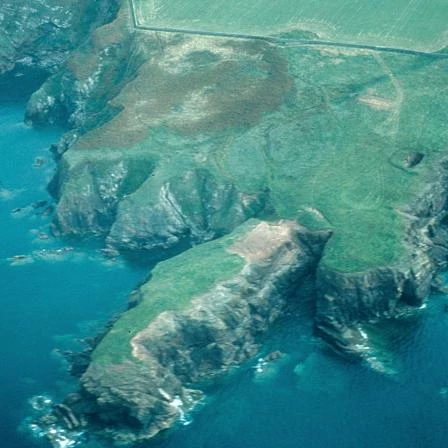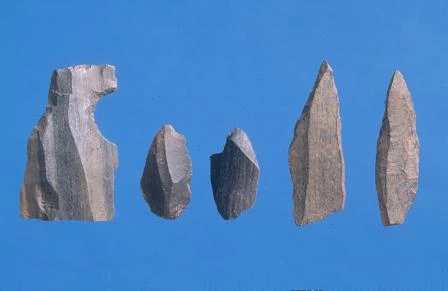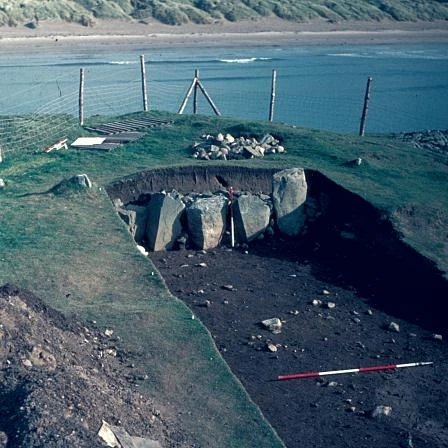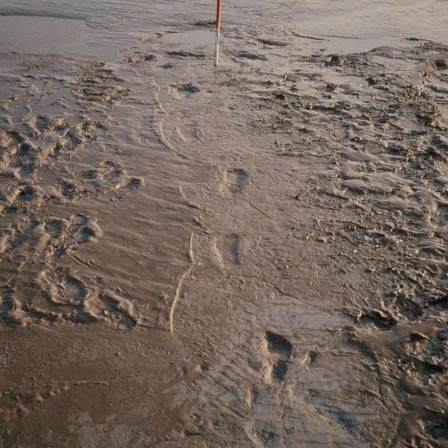After the Ice Age...
The Mesolithic (Middle Stone Age)
The Nab Head (Pembrokeshire). The Nab Head was a seasonal campsite at which stone beads were made. Image © Andrew David.
At the height of the last Ice Age, around 18,000 years ago, Wales was uninhabitable; ice sheets covered almost the entire. As the ice sheets retreated north, people recolonized the land, with the first evidence for occupation in Wales coming from caves, dating to around 15,000 years ago.
About 2,500 years later the climate improved significantly and the population of Britain rose as a result. This period, known as the Mesolithic (or Middle Stone Age), lasted until the introduction of farming around 6,000 years ago.
Woodland landscape
Stone tools from Rhuddlan (Denbighshire). Each tool is about 2.5cm (1 inch) long. A large quantity of stone tools was discovered at Rhuddlan during excavations in the medieval town.
During the Mesolithic, the climate in Britain became warmer and wetter than it is today. This led to changes in the vegetation of Wales with the development of a wooded landscape.
Juniper was the first tree to return, quickly followed by birch, hazel, pine, willow and alder. In the lowlands, oak, elm and pine dominated the landscape, while in the uplands pine and birch were more common. This heavily wooded landscape was home to red deer, roe deer, wild cattle and pigs, all of which were potential prey for Mesolithic hunters. Indeed, it is likely that parts of the woodland in upland Wales was deliberately cleared in order to promote fresh plant growth which would attract grazing animals that could then be hunted for food.
One of the defining features of the Mesolithic was a change in the types of tools that people used for hunting, fishing, and gathering plants. Stone tools in particular became smaller, with tools made on small stone blades becoming common.
A range of stone tools has been found on The Nab Head (Pembrokeshire), which was first inhabited around 8600BC.
Burry Holms
Trwyn Du (Anglesey). The Mesolithic site at Trwyn Du lies beneath a Bronze Age Cairn constructed around 2000BC. It was excavated in 1977 when it became clear that the site was threatened by coastal erosion.
Another campsite of similar age has been found on Burry Holms (Gower). Today Burry Holms is a tidal island but, during the Mesolithic, sea levels were much lower and the island would have been an inland hill overlooking the plain of the River Severn. The rise in sea levels that has occurred since, is a consequence of the melting of ice sheets far to the north.
Excavation at the site has produced a range of finds, including small stone barbs (microliths) used for hunting, and tiny saws. These may have been used for cutting plant stems to make thatch, twine, or fibre for basketry.
Communication between groups may have been fairly easy since it is likely that people spent part of their year travelling in pursuit of herds of animals and other important food sources. During the warm summer months it is likely that they were to be found in inland areas, while in winter they returned to the lower lying coast or river valleys.
Possibly the most important Mesolithic site so far discovered in Wales is at Goldcliff (Newport). This site lies in the modern intertidal zone but, around 7,500 years ago, it sat on a small wooded island surrounded by saltmarsh.
In addition to stone tools, pollen, animal and fish bones were also preserved at the site. Fish is believed to have been important in the diet of Mesolithic people. Their stone microliths (barbs) would have been attached into wooden spears, ideal for fishing.
Given the abundance of animals to hunt, fish to catch, and plants to gather, it is difficult to understand why Mesolithic people began to turn their back on their traditional lifestyle around 6,000 years ago as farming became the dominant means of supporting the population of Wales.
Uskmouth Footprints
Uskmouth footprints (Newport).
This trail of human footprints is one of three found at Uskmouth that head out towards the sea. Scientific study has revealed that the man who left these prints had a shoe size equivalent to modern UK size 8 (European 42, USA 8.5). He stood about 1.70m tall (5.5 feet), and the way his big toe splays outwards indicates that he was accustomed to walking without shoes.
The footprints have been preserved because very soon after he took his walk a period of hot dry weather baked the mud on which he trod. This mud was then gradually covered over by a layer of peat. Recent erosion in the Severn Estuary has resulted in the exposure of these footprints again, some 6,250 years after this Mesolithic man walked towards the sea.
Background Reading
Late Stone Age hunters of the British Isles by Christopher Smith. Published by Routledge (1992).



